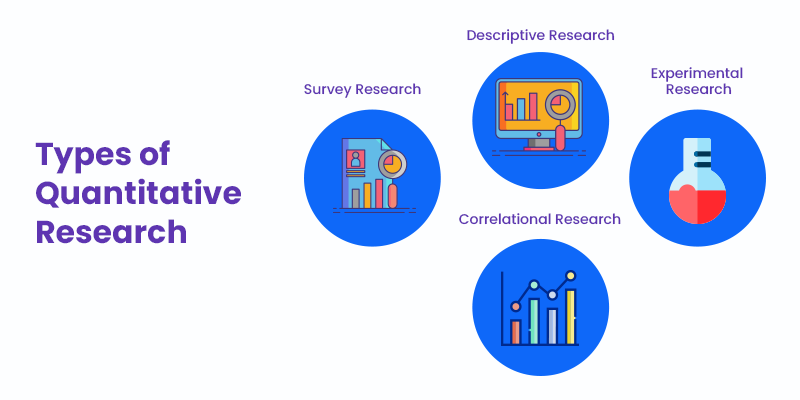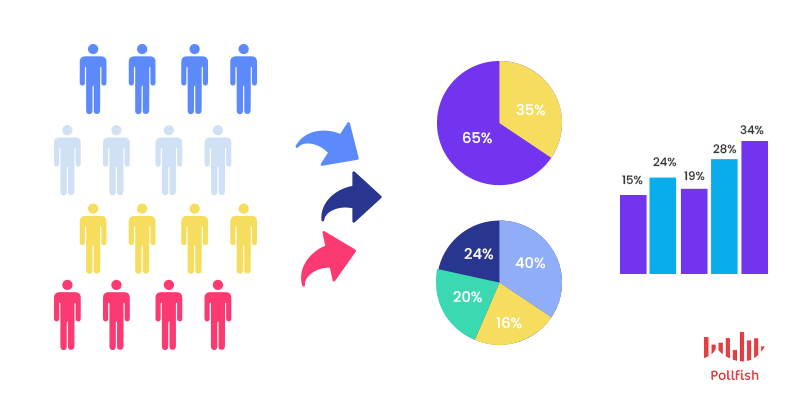The Complete Guide to Quantitative Market Research

Quantitative research is a chief category in the research sphere, along with qualitative research. An encompassing aspect of market research, it can include both primary and secondary methods of extracting data.
Although used interchangeably with qualitative research, quantitative research is a distinct process that should not be confused with its counterpart. In fact, it is the opposite of qualitative research.
Let’s navigate through the waters of quantitative research in this complete guide.
What Defines & Makes Up Quantitative Research?
As its name suggests, quantitative research is the process of aggregating quantitative, or numerical data for research purposes. This data is used for a number of applications. These include:
- Quantifying opinions, behaviors, attitudes and problems
- Making generalizations
- Forming predictions
- Discovering patterns
- Determining averages
- Testing relationships
Quantitative research generally relies on a larger sample size in order to quantify any issue or variable. In order to achieve this, this research method involves using mathematical and statistical means.
This type of research answers the “what” and the “how much” of a subject within a research endeavor. As it forms generalizations, this type of method involves surveying a larger population, using measurable data and processing all the data first and then analyzing it from a statistical standpoint.
The Four Main Types of Quantitative Research
There are four main ways to perform quantitative research. Aside from their methodology, these sub-categories also seek different types of answers and conclusions.

1. Descriptive Research
This is used to determine the state of variables. It describes the situation and environment surrounding a variable or topic. As such, it is used for arranging comparisons, outlining sample characteristics, overlooking emerging trends and confirming existing phenomena.
The data is collected by way of observation. Descriptive Research is used to form a hypothesis, but only after having aggregated all the necessary data.
2. Correlational Research
This research method is used to examine the relationships between different subjects and variables. Analyzing relationships is necessary to either test a hypothesis or a prediction. Because this research focuses on relationships between fixed variables, other outlying variables are not part of the investigation.
Correlational research is in direct opposition to experimental research, as none of the studied variables are manipulated. Correlations can be either positive or negative, with different degrees of the relationship’s strength.
3. Experimental Research
This method is used for finding whether there is a cause and effect relationship among variables. This kind of research relies on the scientific method. Unlike correlational research, experimental research involves manipulating variables.
Researchers would manipulate a variable to uncover its effect on another one. This method is frequently referred to as true experimentation, as no experimental undertaking leaves all variables unchanged; at least one must be influenced in some way.
This includes manipulating, randomizing or reverting back a variable. The variables are then measured, calculated and compared.
4. Survey Research
The final research method is crucial to understanding behavior. In market research, it is often used to acclimate a brand with its target market’s desires, needs, points of contention and behaviors.
Surveys allow researchers to ask pointed questions to either discover their target audience or get a granular sense of their opinions. As such, they can be conducted within one group or many, for the sake of comparison.
Instead of turning to survey panels, which are likely to have skewed or biased results, researchers should use a random sample of people. A non-panel-based survey will garner more respondents that aren’t motivated by professional compensation.
Surveys can be administered by mail, in-person, on the phone, or digitally using various market research tools. Digital methods offer even more options, including online surveys, third-party platforms, email, and in-app surveys.
Examples of Questions for Quantitative Research
Survey research has a far larger scope of questions than do the other three types, as researchers can ask practically anything to conduct their studies. However, there are some best practices in survey questionnaires, such as focusing on your industry, your product and the desires of customers.
Learn more about asking insightful market research questions. Here are a few examples of quantitative research questions in the three other categories.
- Is working from home the best option to improve productivity for employees with long commutes?Variable: Working from home and in-office
Demographic: Employees with long commutes
Quantitative Research Type: Experimental - How has the coronavirus changed employment for white-collar workers?
Variable: Employment types and statuses
Demographic: White-collar workers
Quantitative Research Type: Experimental - How often do working people travel for a holiday?
Variable: Amount of times respondents travel during a holiday
Demographic: working people
Quantitative Research Type: Descriptive - How much would you pay for a subscription to an entertainment magazine?
Variable: payments for a magazine subscription
Demographic: women aged 14-44, those interested in celebrities
Quantitative Research Type: Descriptive - What is the difference in smartphone usage between Millennials and senior citizens?
Variable: Time spent on using a smartphone
Demographic: Millennials and seniors
Quantitative Research Type: Correlational - Does the leadership style of car shop owners predict the job satisfaction of car salespeople?
Variable: Leadership style and job satisfaction
Demographic: Car shop employers and salespeople
Quantitative Research Type: Correlational
When to Use Quantitative Research and How to Analyze It

The quantitative research method has specific use cases. You ought to consider which is best for your particular business, which includes your strategy, your marketing and other facets.
The core of quantitative research is to quantify a phenomenon (a problem, an inadequacy, and a slew of other occurrences) and understand its prevalence. Researchers do this by observing large portions of a population.
You should use this form of research whenever you need to be presented with the state of things at a higher level, or from a bird’s eye view. This Is because this type of research can identify links between various factors, look for correlations and discover cause and effect relationships.
Researchers can then use the results of their findings to form predictions. This is useful in market research when launching a new product, brainstorming product ideas or innovations or growing a customer base.
To analyze this research, it should first be made quantifiable and objective. Researchers should pin down the scales and units of measurements in their various studies. Then, they should organize them into easily interpretable formats.
For example, once you gather the numerical data, you can enter it into a spreadsheet. Thereafter, you can organize it by desegregating it into graphs, charts and tables. Finally, you should draw data-based conclusions from your study. You can also do further sleuthing via advanced analytics, which is made easier using a survey software for market research.
The Benefits and Drawbacks of Quantitative Research
Quantitative research has a bevy of benefits; it also has some hindrances. You should peruse both the positive and negative qualities of this research type before setting out on any major research project. The following may help you choose one form of research over the other, or use aspects of both.
Benefits
- Larger sample pools: the larger the group of respondents, the more accurate are the results.
- Highly structured: Surveys, questionnaires, and other tools for recording numerical data
- Focused: The design of the study is determined before it begins
- Theory-based: Research tests a theory to provide support/proof
- Designed to Be Analyzed: Numbers/statistics exist as tables, charts, figures and other non-textual forms for easy analysis.
- Objective: Steering clear of bias as the research is separated from the data & only objective responses are sought.
- Direct comparisons of results: The study can be set in different cultural environments, times or different groups of participants with a statistical comparison of results.
Drawbacks
- Focuses solely on numbers: This can be limiting as researchers may overlook other data and larger themes.
- Superficial Representations: It cannot adequately describe complex concepts (ex: feelings, opinions) it only shows the numbers behind them.
- Several factors can invalidate results: A hypothesis and a model for collecting/ analyzing data.is required; any mistake can lead to bias and inaccurate illustrations.
- Erred Structure: If any data is missing or if measurements are not clear, biases easily take precedence.
The Final Word on Quantitative Research
Market research is far too encompassing to fully complete, especially in a limited amount of time. To tackle market research, begin with a research method. Quantitative research is often a good starting point to get survey responses, as it shows you the existence of a problem by way of quantifying it.
Aside from confirming the existence, it can help confirm a hypothesis, find correlations and prove cause and effect relationships. A hard set of data can also help you make educated predictions.
While the three types of quantitative research methods are useful, they do have several disadvantages. The fourth one, ie, survey research helps fill in the gaps and inadequacies of numerical limitations. Interestingly enough, they too can be a source of hard data and numbers.
Either way, market research is sure to benefit from incorporating surveys as part of the processes.
Frequently asked questions
What is quantitative market research?
Quantitative market research utilizes the techniques of quantitative research in order to better understand the target market. In quantitative research, the information gathered from surveys and questionnaires is converted into numerical values so it can be easily analyzed.
What types of questions do quantitative research answer?
Quantitative research seeks to define “what” and “how much.” It is used for identifying patterns, making predictions, establishing averages, and quantifying opinions, attitudes or behaviors.
What are the four main types of quantitative research?
The four main types of quantitative research are survey research, correlational research, descriptive research, and experimental research.
What type of surveys are used for quantitative research?
Quantitative surveys are best suited for quantitative research. In this type of survey, there are no open-ended questions, and all responses can be assigned a numerical value. In most cases, a quantitative survey is distributed to a large and random sample of individuals.
Why are large sample sizes important when conducting quantitative research?
A small sample size can lead to inaccurate results. The larger the sample size (i.e. the group of individuals who receive the survey), the more likely it is that the results will be statistically significant and accurate.
Pollfish Marketing Team
Ready to Try Pollfish?
Create your survey with AI, target high-quality respondents starting at $0.95 per complete, and start getting results in just minutes in real-time. From running a simple product concept survey to managing a constant stream of trackers for dozens of clients in dozens of countries, we’ve got you.
